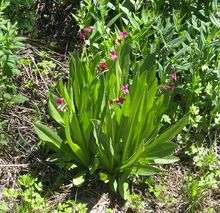Primula parryi
Primula parryi, or Parry's primrose, is a herbaceous perennial native to wet areas from the subalpine zone to alpine tundra in the Rocky Mountains from Montana to Arizona and New Mexico.

whole plant
| Primula parryi | |
|---|---|
| Scientific classification | |
| Kingdom: | Plantae |
| Clade: | Tracheophytes |
| Clade: | Angiosperms |
| Clade: | Eudicots |
| Clade: | Asterids |
| Order: | Ericales |
| Family: | Primulaceae |
| Genus: | Primula |
| Species: | P. parryi |
| Binomial name | |
| Primula parryi | |
Flowers are magenta with yellow eyes. In the high mountains, they bloom in summer; at lower elevations, in late spring.
The whole plant has a skunklike smell.
Asa Gray named Parry's primrose for Charles Christopher Parry, who discovered it in 1861. Parry had previously named Grays Peak after him.[1]
References
- Houk, Rose (1987). Wildflowers of the American West. San Francisco: Chronicle Books. ISBN 0-87701-424-8.
| Wikimedia Commons has media related to Primula parryi. |
External links


- Southwest Colorado Wildflowers
- Primula parryi in the CalPhotos Photo Database, University of California, Berkeley
- Native Plant Identification Network,
This article is issued from Wikipedia. The text is licensed under Creative Commons - Attribution - Sharealike. Additional terms may apply for the media files.